
Graham Collicutt
-
Posts
189 -
Joined
-
Last visited
Posts posted by Graham Collicutt
-
-
Here's the link to that single action tenor on Ebay.
Auction ended early.
Lovely! I don't think I've ever seen a single-action Æola before. (I wouldn't be surprised if Chris Algar has, though.)
But it's odd that the Wheatstone ledger entry doesn't match Chris' description or photos. The ledger says that serial #29958 has 48 buttons, not the 43 pictured. Nothing in the ledger about single action or tuning in F, either, though the entry for serial #29953 does say "in F".
I think you did well to avoid a single action box, no matter how fast the action in the other direction. I wouldn't like to have to sneak in a whole lung-full of air every bar or two; permissible in an ensemble but a swine for a solo line.I would bet that this instrument would be able to do far more than a bar or two before needing a new "breath". And the couple of single-action concertinas that I've been lucky enough to try have been able to gulp an entire "lung full" in the space of a grace note. The "gills" in the bellows make it possible to open even a bass astonishingly quickly.
I am the culprit for ending the auction early. The serial no. should have been 28953.
The B flats and Bs will not swap over without surgery to the B slots as the B3 reed is at least 5 mm shorter. See attached with 2 reeds waiting to be put back in. I will leave it as it was made. All the D sharps are D flats.
It does play very fast and it doesn't use much air for the top 2 octaves; 8 bars of melody. I am getting used to finding the right place to gulp some air.
Graham Collicutt
-
Thanks for the constructive advice and encouragement.
I think I am developing a set of standard fingerings with a few standard "emergency variations".
For a simple 4 button tune in C, I'd tend to just play on the C row.
If I need the 5th button, or the 4th button appears too often, then I tend to cross the row to the G row instead. There are two obvious ways to do this, either using the G push on the C row or the G push on the G row as necessary.
After that, there are useful options like using the draw C on the G row on the left hand, and sometimes both notes on the D/E button on the G row on the left hand.
My question was really to do with the advisability of using notes from the left hand G row that would normally be played on the right hand C row. I've found a few examples where this either makes a more fluid melody possible, or it helps with bellows direction (or both).
The position of the air button is definitely a niggle for me. I have picked up other, smaller, concertinas and had no problem. I am familiar with how an air button ought to work from playing melodeon, so it's not the timing or co-ordination, so much as reaching the bloomin' thing!
As for chords - for some reason, these really aren't coming. The theory is all there - I used to be able to write 2 and 3 part harmony many years ago, and I can use the basses reasonably creatively on a melodeon.
However, the Anglo seems to want me to play it in mainly single notes, with very occasional fills or vamps, rather like many people pay the English. Maybe it's because I haven't heard enough Anglo being played well, and maybe it's partly the tuning of the reeds which make the chords sound too stodgy for my liking when I do play them.
Still, I'm only about a month or so into my Anglo career, so there's a long way to go yet.
A quick extension to air button. 2 coins, one with hole size of air button, glued with hot melt.
I first did this to releave pressure on a chap on side of thumb. This was the head of a stainless steel bolt cut down about 5 mm thick, which looked much better. I kept that for at least 10 years before losing it.
Breaks off when needed for repairs and reapplied with heat to coins.
-
Thanks for posting the test recording. As someone who has placed an order for a G/D from Wim I am very pleased to hear one for the first time. I have a Phoenix so I did know I shouldn't be disappointed. As the lightness of the Phoenix is one of it's assets I would be interested to know the weight. If you could re-record The Old Resting Chair it would display it's performance of the lower octave and would be a good guide to how the G/D will sound.
Graham
Graham
To avoid any misunderstanding, my W-A1 is a C/G. FYI: the weight is 1090 gram, which is (as far as I know) rather low. My original recording of the resting chair is on a G/D Marcus. I might give it a (low) try on my W-A1.

Sorry, I know the new one is C/G but wasn't checking to see what you played The Old Resting Chair on. My Phoenix, open fretwork, flat veneered ends weighs 1010 gram (aprox. dubious kitchen scales). Thankyou for info.
Graham
-
So since last Friday I am the proud owner of a Wakker W-A1 with black raised hardwood ends. I tried to make a decent photo, but black shining subjects with reflections of light are difficult! Will try to make a better one in future.

On top of that I did not take to much time to make pictures.. there were better things to do like playing this beauty. In order to follow the developments in sound of this instrument, I made a reproducible simple recording set-up and played (and recorded) without caring for mistakes in one take the scale C and G, followed by a hornpipe and a slip jig.
You can listen to this test-recording (2.1 Mb, 128kps) and in future I will repeat and record the same sound set.
Although this concertina is completely new and not "broken in" at all, my impressions are very postive. Knowing that the performance will improve in time, I have high expectations of this instrument.
To finish this message: I really enjoyed the contacts I had with Wim and all his advice about breaking in and taking care of the instrument.
Thanks for posting the test recording. As someone who has placed an order for a G/D from Wim I am very pleased to hear one for the first time. I have a Phoenix so I did know I shouldn't be disappointed. As the lightness of the Phoenix is one of it's assets I would be interested to know the weight. If you could re-record The Old Resting Chair it would display it's performance of the lower octave and would be a good guide to how the G/D will sound.
Graham
-
Jeff, are you sure that what you're hearing is entirely a separation? What's perfectly natural when trying to make a quick bellows change is to do it with sudden force. But that creates a dynamic accent, a "punch", which emphasizes the change. Try to keep the pressure as constant and equal on both sides of the reversal, i.e., make the change quick, but gentle. That should de-emphasize the gap itself, rather than creating a dynamic "edge" that makes it more obvious.
Jim,
What I would ideally like is for note changes that occur when changing bellows direction to be as smooth as when just changing notes when moving in the same bellows direction. A nice smooth legato. I realize it can't be exactly the same thing, but I'm trying to get it much smoother. For example, I'm working on "Miss Thornton's" and in the beginning measure there is a nice arpeggio "G2Bd gdBd" which is nice and smooth since on my G/D it is all on a push. In the next measure there is "cBAB cedc" which involves alternating push/pulls with note changes. I'd like to get them both similar in texture, e.g. legato, as I can.
To make sure I understand what you're saying, I believe it is that there is a certain amount of pressure that exists inside the bellows and as long as I can maintain the pressure whether on a push or pull the note changes should be much more similar. I just tried this focusing on that and it definitely makes a difference. I just need to practice^3

Thanks for the help. As a marooned beginner it means a lot to me.
-jeff
Jeff
Why don't you play second phrase all on the pull; Bs off left D row and d off accidental row.
-
Sean Ryan's Polka
My concertina has the Wheatstone fingering, so I have only one reasonable choice for this tune: B C# d on the push, with B and d in the left hand and C# in the right. If I understand you correctly, I run into the same problem in other situations though. For instance, in Em tunes B is often right after E, and I often want to play both notes with the left hand. So what I have learned to do in that situation is cross my ring finger in underneath for the B. Or if I want to play (high) e after A, top buttons of C and G rows on the left hand draw, I will drag my index finger across from A to e. Both of those are tricks I thought were nuts until I had been playing for a couple of years.
I'm not so sure about that right hand draw C# though. It's on the top button of the accidental row, right? Can you reach B on the draw with your middle finger, C# with your index finger, and d with your ring finger?
Actually, I tend to just play both the B and C# with my index finger... I've never actually done the crossing the fingers under each other movement. I just jump up there very quickly with the same finger.... luckily my concertina has short, rounded buttons so it's easy to slip up there. But maybe I'll run into trouble with my technique later if I don't change this now, what do you think?
Another suggestion :- pull b second finger, pull c# index finger, pull d second finger.
-
Well if you are looking for more than 30 buttons (and for the music you play I can certainly see why) you have excluded immediately any maker using accordion reeds. (I know of one maker who is working to develop such a concertina, but it's not on the market yet). This leaves you 2 options, it seems to me:-
- Colin Dipper or Steve Dickenson
- A vintage instrument
Option 1 means joining a waiting list that is several years long. Your patience will, however be rewarded by a magic concertina tailored to your requirements. For option 2, I would suggest giving Chris Algar a ring and seeing what he has in stock. A nice Wheatstone 40-button Linota would be right up your street, both for tone and versatility, I should have thought.
Whatever happens you won't see much, if any, change from 3000 pounds.
Chris
Edited to add PS: Chris's phone number is in the FAQ - see below
A C Norman is making 36 button anglos.
- Colin Dipper or Steve Dickenson
-
I posted F/C Wheatstone Linota in the Buy & Sell forum on 2nd July 2005 with photos, one comparing size with G/D Jeffries. It was very similar in weight to the 38 button Jeffries and could be played almost as fast, but was best used for song or Playford. Chris Algar described it as a tenor when he sold it.
That's interesting. This shows that, on the one hand, some F/Cs were made to "standard" size, and from your description have similar handling characteristics. On the other hand, some (like mine) were made to baritone size and with the playing characteristics of a baritone. It would be interesting to compare the sound of the two and hear whether the larger size really makes a difference.
I guess that knocks my theory of a high-pitched C/F on the head! Nevertheless, whilst it may not be strictly correct to call my instrument a baritone, I persist in thinking that it fits best into that category. "Tenor" may be more accurate, but to me would imply a standard-sized body.
If you look at the photos, you'll see it was a large bodied anglo; the reeds would have been at least 50% larger than the equivelent reed on the G/D.
-
BTW,mine was ebony ended, metal buttons.I've been trying to get a pic to stick, but there's a global overload, or something. I sent you pics in 2003 so you may well have them in your archive.
OK, I thought I remembered yours as ebony ended, but I found pictures in my archive of a metal-ended, large anglo, labelled "Linota F-C", so I thought my memory was wrong. Now I'm wondering where I got those photos, and where I put yours. Obviously not a unique setup, is it?

I posted F/C Wheatstone Linota in the Buy & Sell forum on 2nd July 2005 with photos, one comparing size with G/D Jeffries. It was very similar in weight to the 38 button Jeffries and could be played almost as fast, but was best used for song or Playford. Chris Algar described it as a tenor when he sold it.
-
On the 21st of July my daughter Maggie and I will be arriving in the UK for a 3 week visit!
We (my wife and I) are crossing the same day the North Sea to arrive in Harwich with car and caravan. Our first aim is to join a wedding near Stratford-upon-Avon on Friday 22nd of July. After that the only thing that is sure, is a visit to family in Dundee (son, daughter in law & 3 grandchildren). We should be back in Harwich on the 7th of August (early in the morning).
Suggestion on Concertina events etc. are welcome, but I promised my wife that our trip will not be a concertina pilgrimage. As far as it looks now tips on camping places are also welcome.
Thanks!
Warwick Folk Festival runs 21st - 23rd July and is 10 miles from Stratford. Local sessions run on Sunday and Thursday nights.
-
Sorry, Jeffries is not for sale and Linota has returned to it's source and replaced with tenor aeola.
-
-
I paid £3500 for this Wheatstone 31 key anglo 12 months ago, 7 fold bellows, 175 mm across the flats. Due to the inside row only being 40 to 45 mm from the hand rail and the buttons only 10 mm below the hand rail ( raised ends ) I have difficulty playing the C row due to large hands. ( My 1st finger knuckles; not those closest to finger nails; are over the accidental row ) I don't want to alter the original condition of this wondrous sounding concertina if there is anybody interested. S midlands UK

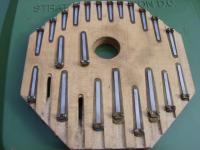
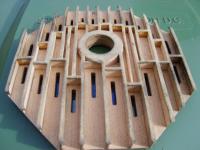
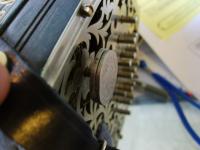
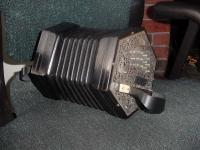
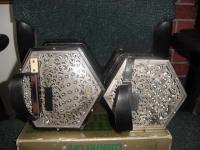
Playing Tunes In Sets
in Tunes /Songs
Posted
Try this http://comhaltas.ie/blog/post/foinn_seisiun_online/
Graham